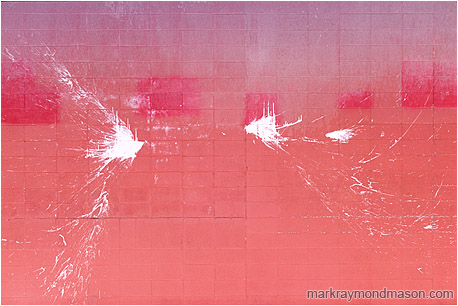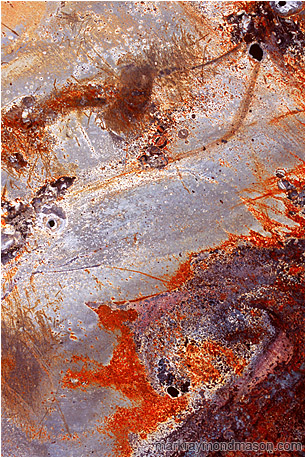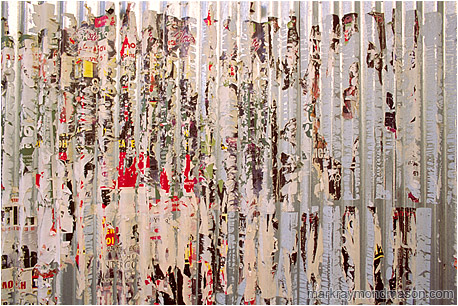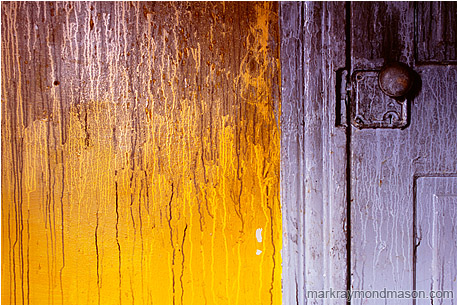For this idea post, I wanted to put down some ideas I've been thinking about.
1. This one might be too crazy and inaccessible because I think it has the problem of utilizing a made-up language, which I guess is like what I was doing before. Another problem is that it brings me away from photography and more into sculpture. Here it is anyway... When I hear music I often find different instruments or melodies to have textures, sizes, or some dimension or quality about them that brings a feeling, when I try to identify these feelings words like silky, tight, or wet are what come to mind, among others. For example, a bassline can be hammocking a chunky guitar with a sticky drum. When I hear this song I dont imagine a hammock filled with peanut butter but when I try to rationalize the words for the feelings that each part gives me, that is what comes to mind. What I love about this idea is the abstractness and absurdness of it. A problem that I am having with using imagery is that I feel a pressure to have actual 'things' in my photos, which feels at odds with instrumental music, and in this case, I feel like the quality of the materials would be important and would be lost in a photo.
2. In an attempt to make it more about photography, I thought to try shooting photos with long shutter speeds while making a sound recording of that same moment. It seems interesting to me but I'm struggling with what meaning it has. What is the implication of the image being still? Make it moving and it is a video. Is it a statement on the nature of photography? Is it about time? A photograph can contain a moment in time, whether a fraction of a second or 30 minutes but no matter how long, it can be experienced instantly. Sound can only be depicted through time, or in a visual representation which is then essentially a photograph which could not be identified by anything other than 'a sound wave' by a viewer. Perhaps in this type of work I would be dealing with ideas about how accurately a photograph can portray life. I'm not sure, I dont know if this is a good idea either.
3. I imagined something more interactive that deals with the same stuff I've been working with. I thought about fashioning a keyboard that lights up and is basically a manifestation of the color/music theory I've developed. The viewer immediately sees how the colors of the rainbow are related to the keyboard, so if they were to play a set of complimentary colors they hear it as harmonious. In theory, someone who is really in touch with color relationships might be able to play the piano beatifly without knowing anything about music, but by simply choosing key combinations based on their colors.
I like this idea the most, however, I imagine a slew of technical aspects that might make it impossible. It also isn't photography. For some reason I can't seem to develop ideas that stay exclusively in the realm of photography. All of these still are incorporating music or sound in some way but for a lot of reasons I feel like should try to not even use sound or music at all. But how can I express the ideas I'm working with, without the element of sound? Can I make photography that truely has the experience of music? I don't know, I've gotten myself pretty confused at this point.
Thursday, February 25, 2010
Monday, February 22, 2010
Artist #7 - 2.22.10 - Christian Marclay
During our meeting, Paul suggested I look at Christian Marclay. He was one of the first people to use turntables as an instrument, independently, but around the same time as hip-hop artists were beginning to do so as well. Most of his work deals with altering or destroying records to produce interesting music loops or soundscapes. My criticism is that he doesn't make music so much as he just makes noise, or "sound collages". I understand that he is an innovator of this sort of thing but my interest ends there. I suppose it's hard for me to grasp why you would want to make music sound bad. Of course this gets into the whole discussion of what 'good' music even is which could be a whole other blog post.
The method of using multiple musical samples to make something new reminds me of a lot of modern music. DJ Girl Talk is someone who is pushing the limits of this method but doing it in a much more musical way than Marclay. He takes parts of numerous hit songs and arranges them in such a way that they continuously and seamlessly play play with and mold into one another. Also on a less notable level, in the recent past it was the standard for hip-hop artists to make beats composed of sliced samples of old records and turntable scratching. Marclay's work reminds me of non-rhythmic hip-hop.
Marclay also does visual work although, like myself, his visual work seems inferior to his audio work(aside from his installations, which I like the most). Here are a few of those,
 Christian Marclay, Ensemble, 2007
Christian Marclay, Ensemble, 2007
 Christian Marclay, Ensemble, 2007
Christian Marclay, Ensemble, 2007
Christian Marclay, Video Quartet, 2002
I found an interview with him where he mentions something that reminds me a lot of myself, in it he says, "Being in art school and wanting to make music was not an obvious choice but I felt a lot more energy coming out of the music world than from the art world. When I was visiting New York on the weekends, I tended to gravitate more towards what was happening in music clubs than towards what was happening in museums and galleries." To be perfectly honest, I have little interest in the art world, but I could spend hours in the basement at Plan 9. It's not that I don't like art, I just don't like what art is these days. So instead of looking for visual artists, I usually spend more time looking for new musical artists. It seems like other artists keep up with artists the way I keep up with musicians, looking for their new work or where they are showing next. I came to school to learn how to be a photographer, not necessarily a fine art photographer. But since that's what I'm doing, I feel like I can use music more expressively as art than I can photography.
The method of using multiple musical samples to make something new reminds me of a lot of modern music. DJ Girl Talk is someone who is pushing the limits of this method but doing it in a much more musical way than Marclay. He takes parts of numerous hit songs and arranges them in such a way that they continuously and seamlessly play play with and mold into one another. Also on a less notable level, in the recent past it was the standard for hip-hop artists to make beats composed of sliced samples of old records and turntable scratching. Marclay's work reminds me of non-rhythmic hip-hop.
Marclay also does visual work although, like myself, his visual work seems inferior to his audio work(aside from his installations, which I like the most). Here are a few of those,
 Christian Marclay, Ensemble, 2007
Christian Marclay, Ensemble, 2007 Christian Marclay, Ensemble, 2007
Christian Marclay, Ensemble, 2007Christian Marclay, Video Quartet, 2002
Saturday, February 20, 2010
Idea #6 - 2.18.10 - Tryin to think outside the frame
During my individual meeting with Paul, we discussed how I could bring my photography to have the same impact as my music. He suggested that I try to ignore what I think the rules of photography are and use imagery in any way I can to get the effect I want. Some ideas I have been working with are multiple images that together can created a mood or scenario, not just in their content but in their arrangement, repetition, and colors. However, I am afraid that this language may brush too close to what a movie or music video is. It is still a bit unclear to me as to how I can really build a strong relation to the music in this way without becoming too much like a music video. I think perhaps the difference is that I believe that qualities of music can be captured in still imagery, I just need to find an effective way of communicating this. I also want to toy with how music changes the context of an image. For example an innocent image may become sinister in combination with ominous music, and then may change back to playful with a happier tune or vice-versa. And although I know the language I have created of connecting colors to musical notes seems to be inaccessible, I still want to incorporate it. Griffin suggested that I use a sort of key in my artist statement, which I think would be helpful in understanding my work.
Artist Lecture #1 - 2.16.10 - Hank Willis Thomas
I attended the Hank Willis Thomas lecture and thought that it was good. Particularly his stuff that deals with advertising. I thought it was funny what he said about MasterCard having an ironic name because most of us are in debt to them. His series Br@nded was really cool, and I found it interesting what he said about when he was showing the series people didn't know that they weren't advertisements. It makes me wonder how much people were even paying attention, because although they have the language of advertising, they clearly are 'advertising' a different agenda. My favorite piece was this one,
 I thought it was interesting how he has shown basketball as a means of holding down black people. It seems that the media has convinced many black men that basketball or rap music is their only way to success, limiting their progression in other areas. And something interesting he said was "we came here in chains and now we're still wearing them." And of course, the reason is not as any sort of memorial, but rather a perpetuation of the media's portrayal of black men.
I thought it was interesting how he has shown basketball as a means of holding down black people. It seems that the media has convinced many black men that basketball or rap music is their only way to success, limiting their progression in other areas. And something interesting he said was "we came here in chains and now we're still wearing them." And of course, the reason is not as any sort of memorial, but rather a perpetuation of the media's portrayal of black men.
I also thought the works where he removed the text out of magazine ads were very interesting, but I found myself wondering what kind of crazy subliminals he could find if he didn't limit himself to portrayals of black people. I understand that the portrayals of blacks is central to his idea, but it is clear, to me at least, that advertising has always been building and perpetuating some strange TV world of misplaced ideals and skewed interpretations of real life.


 I thought it was interesting how he has shown basketball as a means of holding down black people. It seems that the media has convinced many black men that basketball or rap music is their only way to success, limiting their progression in other areas. And something interesting he said was "we came here in chains and now we're still wearing them." And of course, the reason is not as any sort of memorial, but rather a perpetuation of the media's portrayal of black men.
I thought it was interesting how he has shown basketball as a means of holding down black people. It seems that the media has convinced many black men that basketball or rap music is their only way to success, limiting their progression in other areas. And something interesting he said was "we came here in chains and now we're still wearing them." And of course, the reason is not as any sort of memorial, but rather a perpetuation of the media's portrayal of black men.I also thought the works where he removed the text out of magazine ads were very interesting, but I found myself wondering what kind of crazy subliminals he could find if he didn't limit himself to portrayals of black people. I understand that the portrayals of blacks is central to his idea, but it is clear, to me at least, that advertising has always been building and perpetuating some strange TV world of misplaced ideals and skewed interpretations of real life.


Monday, February 15, 2010
Artist #5 - 2.15.10 - Ciro Totku



Today I want to talk about Ciro Totku. He is a Russian abstract photographer working in Cambodia. Totku finds his images mostly in nature and although I chose him for his use of color, not all his work is in color. His work is similar to the last photographer I talked about, Mark Mason. While looking through his work, I found myself often wishing I had some of these bright colorful images to explore musically. When I shoot I tend to focus on compositional elements, and while I enjoy his compositional sensibilities, his work has inspired me to look more for colors and interesting color relationships. I realized that this is the most important thing I could do considering my work is all about relationships between colors and musical notes. The more complex my color relationships, the more interesting my musical scores could be.
Saturday, February 13, 2010
Research #4 - 2.11.10 - Room Acoustics
A big part of my work, particularly on the audio side, is the space in which I create the work. The shape of a room, placement of speakers and combination reflective and non-reflective surfaces play a huge part in how I hear and record sounds when making my work. This is also something that should be considered for exhibition as it will play an important role in how the viewer hears the work. To begin, I am recording and mixing in the extra room of my apartment. It is roughly 9'x14' with high ceilings. Ideally, I would like to be in a perfect acoustically engineered recording studio, but given the space that I have, I need to optimize it's acoustic properties. Fortunately, the room is rectangular, which is not ideal, but in my research I found that a perfect cube is the worst possible scenario. The fewer parallel surfaces the better, so that certain frequencies do not build up. I had covered most of the walls with egg cartons because I believed it provided a better listening environment, but in my research I found that they are really only useful to dampen the sound. This will be good for recording, as it will reduce background echoes, but it leaves me needing panels for sound absorbtion when mixing. For now I will have to rely on my couch as my main place of absorbtion but I have also read that large pillows in the corners are a cheap solution for bass traps. A bass trap is an absorbtion device that prevents uneven bass response so that certain frequencies do not get amplified or lulled by the shape of the room. I read that in a rectangular room, it is best to face one of the shorter walls when mixing. I also read that having speakers in the corner of a room, or right up against the wall are bad choices so I have placed my speakers about 1.75' from the 9' wall placed at 46" apart. I read you want to put yourself in an equilateral triangle with your speakers. Therefore, given the distance between my speakers, I have placed my listening position at 5'4" from the wall which puts my speakers at about 30%. After rearranging for this new set-up, I can already hear a difference and new clarity while I'm mixing. I need to read more on how different environments might react and will have to consider this for exhibition once I know the space the work will be in. Here's a picture of the studio:


Wednesday, February 10, 2010
Artist #3 - 2.8.10 - Brian Eno
Since my latest piece is dealing with a sort of transient minimal ambiant type of music, I wanted to talk about Brian Eno. He was one of the pioneers of minimal and ambient music so naturally, I should have a listen to him as one of the firsts. I have his album, Ambient 1/Music for Airports and from what I have heard, his work is very similar to the sound the I am looking for in this particular piece. It is very airy and open. The first song is most like what I am looking for, with a sort of sauntering piano accompanied by some long triumphant pads. Even though this album has plenty of silence, I feel I want even less driving the song foreward, or fewer, but more intense segments of instrumentation. I do like how the songs stay true to their themes; they focus on a certain melody and allow different instruments to carry that melody, lead into or out of it, branch off from it, and sort of hammock it as well. It seems the most important thing is that the melody can stand on its own in the void that is created by the silence. It doesn't leave the listener waiting for more, it is acceptable simply to be let be and contemplated upon before it begins again and continues. Eno's music theory is very complex which is kind of discouraging, but as far as theory goes, I rely on the colors in the photograph to decide that. I am really only taking notes on Eno's style, which is what I will need to understand in order to accomplish the vibe I am looking for.
Idea #2 - 2.4.10 - Snow

I am interested in the ephemeral and the transient, and the snow has provided me a good means of exploring this. The snow falls and melts over time(at least in our part of the world), and can visually bears a resemblance to sound as well. For example Wassily Kandinsky said that the color white represented silence, but a silence full of hope, like a break in a song or the time between songs on an album. In a photograph of the snow, the shape of the tremendous white negative space becomes the subject of the photograph, I am going to work on a song that is more about what you don't hear than what you do. Not in the way John Cage's "4:33" looks at silence as music, but rather to compare the negative space of the photograph with music dealing with negative space, or white noise. The tones of the music will emerge from the ambiance as the snow-shielded dark areas emerge from the blanket of snow. I imagine soft music of an ambient style. My only problem with this is the lack of color variety, I see some reds and blues, but that doesn't give me much to work with musically. Of course, I do want this to be a minimal song, but I will use Photoshop's color-picker to see if there are any more subtle hues that I can derive a musical scale from.
Monday, February 8, 2010
Artist #1 - 2.01.10 - Mark Mason
At the current state of my work, the visual side is represented in abstract photographs. I feel they best portray the abstraction that is music. My music has no lyrics, so I feel my photographs should have no story to accompany them. I am interested mostly in natural abstractions. These scenes can be found anywhere and each one describes something about life, about the way things work and why they are the way they are. For example, this seemingly random, yet organically structured beauty can be found in the way paint chips and peels off of a wall, or in any given gum-spattered slab of sidewalk. No one created these abstractions, they simply came to be. So today I want to talk about Mark Mason, I came across him while researching abstract photography and was pleased to find that his images are very similar to mine. I have heard from people that these types of images are nothing but cathartic work that you do when you're bored. This always discouraged me because that's the work I like to do, I am not particularly interested in post-modernism. I suppose Mason is doing well enough as one of the top rankers in Google for abstract photographer, so he has inspired me to shoot what I want. Here is some of his work,
Visually I enjoy his work a great deal because I feel he has very similar sensibilities to me. Something that struck me as being true to my own work was how Mason describes his methods of making his work, "I create when I feel a connection. A subject's shapes, colours, and textures are only vessels, like words in a poem, to help explain what I feel. To this end, I work with my subjects spontaneously, as I find them, and do all of my creative manipulation with traditional optics, in the field." This feels like an accurate description of what guides me in the creation of my photographs. The shapes, colors, and textures are indeed like the words to a poem, or in my case, the melody of a song. I am taking it a step further by trying to understand these elements further by means of connecting them with music.
Visually I enjoy his work a great deal because I feel he has very similar sensibilities to me. Something that struck me as being true to my own work was how Mason describes his methods of making his work, "I create when I feel a connection. A subject's shapes, colours, and textures are only vessels, like words in a poem, to help explain what I feel. To this end, I work with my subjects spontaneously, as I find them, and do all of my creative manipulation with traditional optics, in the field." This feels like an accurate description of what guides me in the creation of my photographs. The shapes, colors, and textures are indeed like the words to a poem, or in my case, the melody of a song. I am taking it a step further by trying to understand these elements further by means of connecting them with music.
Subscribe to:
Posts (Atom)






